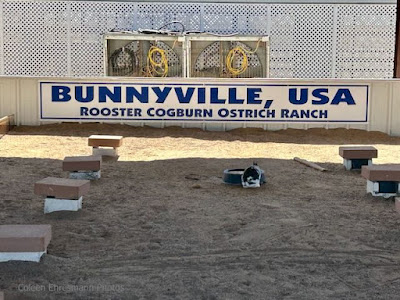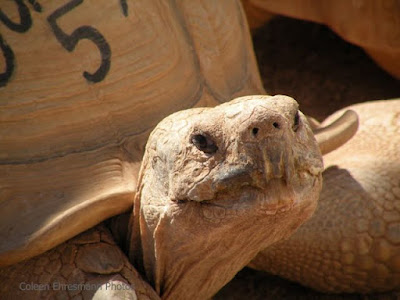Small animals, especially for the kiddos...
Our second food cup contained tokens for food for the bunnies (and chickens and ducks). We gave our tokens to a family with small children.
all colors
this one posed for me
this one looks so soft and furry
I did not see an entrance for the rabbit pen. I think the only touching of the rabbits was if you leaned over the short wall and could reach them.
There was a piece of asparagus in the second food cup to feed the tortoises.
they all had names
I'm not certain if this group of tortoises in the corner constitutes a creep, but that is the term for a group of tortoises. (A group of turtles is called a bale.)
someone doesn't know how to spell
To feed the tortoises we were to place the piece of asparagus in the clothespin (with wings) and hold it slightly to the left of the tortoise's head. When they saw the food, they would quickly snatch it with their sharp beak. They do not have teeth.
The tortoise I tried to feed must not have been hungry as it dropped the food in the dirt. I don't think it was recovered. Tortoises are land creatures and herbivores. Turtles are omnivores.
Because they barely moved, it was easy to take photos of their interesting features. They do not have ears but have a hole on the sides of their heads.
All tortoises are in fact turtles—that is, they belong to the order Testudines or Chelonia, reptiles having bodies encased in a bony shell—but not all turtles are tortoises. Unlike most sea turtles, which take to land only when they are laying eggs, tortoises don’t have much to do with water other than drinking it and occasionally bathing in it. ~ Britannica
Their shell develops from their ribs and is called a carapace. The carapace can help indicate the age of the tortoise by the number of concentric rings, much like the cross-section of a tree.
back feet
One way to further distinguish tortoises from other turtles is to look for certain anatomical features. The testudinids (their family is Testudinidae) are easily recognized because all share a unique hind-limb anatomy made up of elephantine (or columnar) hind limbs and hind feet. ~ Britannica
front feet
Their forelimbs are not flipperlike, and their hind feet are not webbed. Each digit in their forefeet and hind feet contains two or fewer phalanges. Finally, if you can’t see their legs, try feeding them meat. Tortoises are generally vegetarians, while other turtles are omnivorous. ~ Britannica
These teens entered the Tortoise pen to do their feeding. I hope they did not loose a finger in the process! One of the tortoise was parked by the gate making it very hard for us to enter, but these two were able to squeeze through.
There is also a water tank of cownose stingrays for touching and feeding. I chose photography instead.
Ostriches tomorrow!

















No comments:
Post a Comment
Thanks for your comments!